House of Aviz
The House of Aviz (Portuguese: Casa de Avis), also known as the Joanine Dynasty (Dinastia Joanina), was a dynasty of Portuguese origin which flourished during the Renaissance and the period of the Portuguese discoveries, when Portugal expanded its power globally.
| House of Aviz Casa de Avis | |
|---|---|
.png) | |
| Parent house | Portuguese House of Burgundy |
| Country | Portugal |
| Founded | 1385 |
| Founder | John I |
| Final ruler | Henry I or António I (disputed) |
| Titles | |
| Dissolution | 1580 |
| Cadet branches | |
The house was founded by King John I of Portugal, Grand-Master of the Order of Aviz and illegitimate son of King Pedro I (of the Portuguese House of Burgundy), who ascended to the throne after successfully pressing his claim during the 1383–1385 Portuguese interregnum.[1] Aviz monarchs would rule Portugal through the Age of Discovery, establishing Portugal as a global power following the creation of the Portuguese Empire. In 1494 Pope Alexander VI divided the world under the dominion of Portugal and Spain with the Treaty of Tordesillas.
The House of Aviz has produced numerous prominent figures in both European and global history, including Prince Henry the Navigator, King Manuel I of Portugal, and Holy Roman Empress Isabella of Portugal. Numerous Aviz dynasts have also claimed thrones or titles across Europe, including King Peter V of Aragon and John, Prince of Antioch. The Aviz ruled Portugal from 1385 until 1580, when the Philippine Dynasty succeeded to the throne following the Portuguese succession crisis of 1580.
History
_-_Lissabon_Museu_Nacional_de_Arte_Antiga_19-10-2010_16-12-61.jpg)
Origins
The founder of the House of Aviz, King John I of Portugal, was born in 1357 as the illegitimate child of King Pedro I of Portugal, a member of the Portuguese House of Burgundy, and Teresa Lourenço, daughter of a Lisbon merchant. In 1364, at 7 years old, John was made Grand Master of the Order of Aviz, henceforth becoming known as John of Aviz.
Rise to the throne
The House of Aviz was established as a result of the dynastic crisis following the 1383 death of Ferdinand I.[2] Ferdinand's widow Leonor Telles was disliked by both the nobility and the commoners for having left her first husband and for having had their marriage annulled in order to marry King Ferdinand. Ferdinand's designated heir was their only surviving child Beatrice, married to John I of Castile who claimed the throne in the name of his wife,[3] but under the Treaty of Salvaterra that had been the basis for John's marriage to Beatrice, the unpopular Leonor was left as Regent until such time as the son of Beatrice and John would be 14 years old.
In April 1385, amidst popular revolt and civil war, the Cortes of Coimbra declared John, Master of Aviz, as king John I of Portugal. He was half-brother of Ferdinand and natural son of Ferdinand's father and predecessor Pedro I. He had the particular backing of the rising bourgeoisie of Lisbon; the nobility were split, with the majority favoring the legitimist Beatrice. Troops under General Nuno Álvares Pereira defeated a small Castilian army at Atoleiros, while John of Castile had to lift a siege to Lisboa, mainly due to a plague that hit his army and killed his wife Beatrice. This was followed, however, by a larger invasion of Castilian and Portuguese troops loyal to John of Castile.
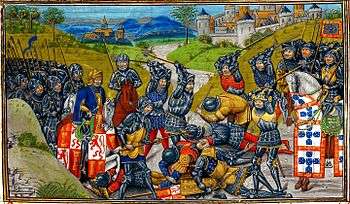
John of Aviz's rule became established fact with the Portuguese victory in the Battle of Aljubarrota[4] on 14 August 1385, where he defeated John I of Castile.[3] A formal peace between Portugal and Castile would not be signed until 1411.
To mark his victory, John founded the Monastery of Santa Maria da Vitória, known as the "Batalha Monastery" ("Battle Monastery"), whose chapel became the burial place of the princes of the new dynasty of Aviz. The descendants of King John I were still also Masters of Aviz, though at times that title passed to one descendant of John and the Crown of Portugal to another. The title of Grand Master of the Order of Aviz was permanently incorporated into the Portuguese Crown toward the end of rule by the House of Aviz, in 1551.[5]
Age of Discoveries
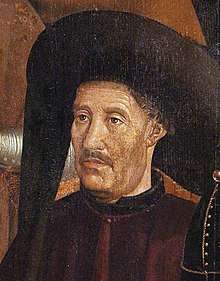
The House of Aviz would rule Portugal until its fall in the 1580 to the Philippine Dynasty.[6] after he had ordered the Duke of Alba to take Portugal by force.[7]
This period of Portuguese history saw the ascent of Portugal to the status of a European and world power. The conquest of Ceuta in 1415 was its first venture in colonial expansion,[8] followed by a great outpouring of national energy and capital investment in the exploration of Africa, Asia and Brazil with the founding of colonies to exploit their resources commercially.[9] The period also includes the zenith of the Portuguese Empire during the reign of Manuel I and the beginning of its decline during John III's reign.[10]
Fall of the Aviz
John III was succeeded in 1557 by his grandson Sebastian I of Portugal, who died, aged 24 and childless, in the Battle of Alcácer Quibir.[11] Sebastian was succeeded by his great-uncle Henry, aged 66, who, as a Catholic Cardinal, also had no children. The Cardinal-King Henry died two years later, and a succession crisis occurred when pretenders to the throne including Catherine, Duchess of Braganza, Philip II of Spain, and António, Prior of Crato claimed the right to inherit it.[12]
_(cropped).jpg)
António, Prior of Crato, was acclaimed king in several cities around the country in 1580, twenty days before Philip II of Spain invaded Portugal and defeated the supporters of António in the Battle of Alcântara. Although António had been proclaimed king, and was still regarded as rightful king in some of the Azores Islands until 1583,[13] his legitimacy as a monarch is still disputed by historians. Only a small minority of historians (even in Portugal) accept the period of twenty days between Anthony's acclamation and the Battle of Alcântara as his reign. In Portugal he generally considered not as a national king, but as a patriot who led armed resistance to the Philippine domination.
Joaquim Veríssimo Serrão, writing in 1956 and counting António as a king, dates the end of the dynasty's rule of Portugal as occurring in 1581–1582. The Cortes of Tomar had acclaimed Philip II of Spain as Philip I of Portugal in 1581, subsequently António's forces were utterly defeated at sea by Álvaro de Bazán at the Battle of Ponta Delgada off São Miguel Island in the Azores, on 26 July 1582. António then retreated to Terceira, where he supervised the raising of levies for defense, but in November he left Angra do Heroísmo en route to France[14] to persuade the French to furnish more troops,[15] 800 of which arrived in June 1583.[16] Philip had despatched Santa Cruz with an overwhelming force which left Lisbon on 23 June,[17] and reaching sight of São Miguel some time after 7 July,[18] finally reduced the Azores to subjection.[19]
The Cortes in Tomar acknowledged Philip II of Spain as King Philip I of Portugal on 16 April 1581 after this Spanish military intervention.[20] From 1581, the House of Aviz had ceased to rule any portion of continental Portugal; António, Prior of Crato held out in the Azores into 1582 as António I of Portugal; the last of his allies in the islands finally surrendered in 1583.[15]
The House of Aviz was succeeded in Portugal by Philip's personal union of the Crowns of Portugal and Spain.[21] In Portuguese history this is variously referred to as the Philippine Dynasty,[22] the House of Habsburg, or the House of Austria. Portugal and Spain would share a common monarch until 1640, upon the proclamation of the Duke of Braganza as John IV of Portugal.[23]
Aviz monarchs

_(cropped).jpg)
- Monarchs of Portugal
| Name | Reign | Notes |
|---|---|---|
| John I of Portugal | 1385–1433 | Founder of the House of Aviz |
| Duarte I of Portugal | 1433–1438 | Oldest member of the Illustrious Generation |
| Afonso V of Portugal | 1438–1481 | |
| John II of Portugal | 1481–1495 | |
| Manuel I of Portugal | 1495–1521 | Formerly Duke of Beja |
| John III of Portugal | 1521–1557 | |
| Sebastian I of Portugal | 1557–1578 | Death at Battle of Alcácer Quibir triggers Portuguese succession crisis of 1580 |
| Henry I of Portugal | 1578–1580 | Last Aviz monarch recognized by the Portuguese Cortes |
| António I of Portugal | 1580 | Disputed reign in opposition to King Philip I of Portugal in the War of the Portuguese Succession |
- Monarchs of Aragon
| Name | Reign | Notes |
|---|---|---|
| Peter V of Aragon | 1463–1466 | Disputed reign in opposition to King John II of Aragon in the Catalan Civil War |
Symbols
Cross of Aviz
Following his success in succeeding to the throne following the 1383–1385 Portuguese interregnum, King John I of Portugal took the Cross of the Order of Aviz as his heraldic badge, adding it to the coat of arms of Portugal and the according royal flags. King John I enforced the imagery of his position as Grand-Master of the Order of Aviz, lending its name to his newly founded royal house and its cross as his personal charge on the royal arms. This was effected in various ways: by insertion within the bordure, alternating with the castles; more commonly inserted within the shield, and occasionally shown outside the shield with the latter laying over it. The Cross of Aviz is a cross flory vert (a green cross with a fleur-de-lys at the end of each arm)
Armillary sphere
The armillary sphere has been an important element of Portuguese heraldry since the reign of King Manuel I of Portugal. The armillary sphere became a royal badge for the Portuguese monarchy, apart from being part of the personal standard of King Manuel I. It acts as a supporter to the Coat of arms of Portugal, also present on the current Flag of Portugal.
Owing to the association with King Manuel I and other Aviz monarchs with the Portuguese discoveries, the armillary sphere was commonly used as a symbol representing Portuguese sovereignty across the Portuguese Empire. The symbol was a consistent motif in both Manueline and Neo-Manueline architecture. It also became particularly associated with Colonial Brazil and the subsequent United Kingdom of Portugal, Brazil, and the Algarves.
An important element of Portuguese heraldry since the 15th century, the armillary sphere was many times used in Portuguese naval and colonial flags, mainly in Brazil. It was a navigation instrument used to calculate distances and represents the importance of Portugal during the Age of Discovery, as well as the vastness of its colonial empire when the First Republic was implemented.
Coats of arms
| Coat of arms | Title | Tenure | Coat of arms | Title | Tenure | Coat of arms | Title | Tenure |
|---|---|---|---|---|---|---|---|---|
 |
.png) |
.svg.png) |
*in opposition to King John II of Aragon |
|||||
.svg.png) |
*jure uxoris through Queen Charlotte of Cyprus |
 |
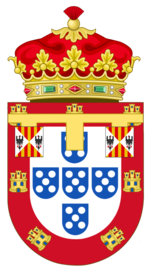 |
|||||
Notable members of the House of Aviz
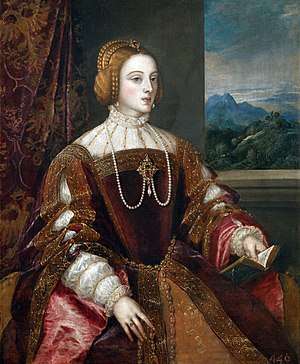
- Peter, Duke of Coimbra, regent of Portugal for nine years.
- Henry the Navigator, Duke of Viseu.
- Isabella, Duchess of Burgundy, twice regent of the Burgundian Low Countries; wife of Philip the Good, Duke of Burgundy, mother of Charles the Bold.
- John, Constable of Portugal.
- Ferdinand the Holy Prince.
- Ferdinand, Duke of Viseu, also first Duke of Beja.
- Eleanor of Portugal, Holy Roman Empress, wife of Frederick III, Holy Roman Emperor, mother of Maximilian I, Holy Roman Emperor.
- Joanna, Princess of Portugal, daughter of Afonso V. Regent of Portugal and Roman Catholic saint.
- Peter, Constable of Portugal, son of Peter, Duke of Coimbra. King of Aragon, count of Barcelona.
- James of Portugal, son of Peter, Duke of Coimbra. Cardinal and Archbishop of Lisbon.
- Beatrice of Coimbra married Adolph of Cleves, Lord of Ravenstein.
- Isabel of Coimbra, daughter of Peter, Duke of Coimbra, first wife of Afonso V, mother of John II.
- Philippa of Coimbra, unmarried, served as a mother to John II after the death of her sister, Isabella of Coimbra. Lived in the monastery of Odivelas.
- John, Prince of Antioch, son of Peter, Duke of Coimbra.
- Eleanor of Viseu, daughter of Ferdinand, Duke of Viseu and wife of John II of Portugal.
- Isabella of Portugal, empress of the Holy Roman Empire, queen of Aragon, Castile, Sicily, and Naples, wife of Charles V, Holy Roman Emperor (Charles I of Spain), mother of Philip II of Spain.
- Beatrice, Duchess of Savoy, daughter of Manuel I, who brought the name "Manuel" (Italian: "Emanuele") into the House of Savoy.
- Louis, Duke of Beja, son of Manuel I, lover and possibly later husband of the beautiful and wealthy New Christian Violante Gomes; their son António, Prior of Crato was the disputed last Aviz king of Portugal.
- Edward, Duke of Guimarães, constable of the kingdom.
- Maria of Guimarães, daughter of Edward, Duke of Guimarães, wife of Alexander Farnese, Duke of Parma (and hence Duchess of Parma), who brought the previously exotic Portuguese cuisine to the rest of Europe.
- Catherine, Duchess of Braganza, daughter of Edward, Duke of Guimarães, niece of King Henry, grandmother of John IV of Portugal.
- Edward, Duke of Guimarães, son of Edward, Duke of Guimarães, constable of the kingdom.
Family tree of the House of Aviz
Peter I king of Portugal PORTUGUESE HOUSE OF BURGUNDY | |||||||||||||||||||||||||||||||||||||||||||||||||||||||||||||||||||||||||||||||||||||
Ferdinand I king of Portugal | (illeg.) John I king of Portugal HOUSE OF AVIZ | ||||||||||||||||||||||||||||||||||||||||||||||||||||||||||||||||||||||||||||||||||||
Edward king of Portugal | Peter duke of Coimbra | Henry the Navigator | John constable of Portugal | Ferdinand master of Order of Aviz | (illeg.) Afonso duke of Braganca BRANCH OF BRAGANZA | ||||||||||||||||||||||||||||||||||||||||||||||||||||||||||||||||||||||||||||||||
Afonso V king of Portugal | Ferdinand duke of Viseu | Peter constable of Portugal | John prince of Antioch | James cardinal bishop | Diogo constable of Portugal | Fernando duke of Braganza | |||||||||||||||||||||||||||||||||||||||||||||||||||||||||||||||||||||||||||||||
John II king of Portugal | João duke of Viseu | Diogo duke of Viseu | Manuel I king of Portugal | Isabel of Viseu | Fernando II duke of Braganza | ||||||||||||||||||||||||||||||||||||||||||||||||||||||||||||||||||||||||||||||||
| Afonso prince og Portugal | (illeg.) Jorge duke of Coimbra BRANCH DE LENCASTRE | John III king of Portugal | Louis duke of Beja | Ferdinand duke of Guarda | Afonso carinal prince of Portugal | Henry cardinal king of Portugal | Duarte 4th duke of Guimaraes | Jaime duke of Braganza | |||||||||||||||||||||||||||||||||||||||||||||||||||||||||||||||||||||||||||||
| João duke of Aveiro | Afonso Comendador-mor of São Tiago | João Manuel prince of Portugal | (illeg.) António king of Portugal | Duarte 5th duke of Guimaraes | Theodósio I duke of Braganza | ||||||||||||||||||||||||||||||||||||||||||||||||||||||||||||||||||||||||||||||||
| George duke of Aveiro | Alvaro duke of Aveiro | Sebastian king of Portugal | Manuel heir apparent | João I duke of Braganza | |||||||||||||||||||||||||||||||||||||||||||||||||||||||||||||||||||||||||||||||||
| George duke of Torres Novas | Afonso nobleman | Peter archbishop of Évora & Braga | Manuel Antonio prince of Portugal | Theodósio II duke of Braganza | |||||||||||||||||||||||||||||||||||||||||||||||||||||||||||||||||||||||||||||||||
| Raimundo duke of Aveiro | John IV king of Portugal | ||||||||||||||||||||||||||||||||||||||||||||||||||||||||||||||||||||||||||||||||||||
See also
- House of Aviz kings of Portugal family tree
- Illustrious Generation
- Portugal in the period of discoveries
- Timeline of Portuguese history
- Descendants of Manuel I of Portugal
References
- António Henrique R. de Oliveira Marques (1972). History of Portugal: From Lusitania to Empire ; vol. 2, From Empire to Corporate State. Columbia University Press. pp. 127–128. ISBN 978-0-231-03159-2. Retrieved 24 June 2013.
- Christopher Allmand; Rosamond McKitterick (18 June 1998). The New Cambridge Medieval History: Volume 7, C.1415-c.1500. Cambridge University Press. p. 629. ISBN 978-0-521-38296-0. Retrieved 24 June 2013.
- Guida Myrl Jackson-Laufer (1999). Women Rulers Throughout the Ages: An Illustrated Guide. ABC-CLIO. p. 52. ISBN 978-1-57607-091-8. Retrieved 24 June 2013.
- Clifford J. Rogers; Kelly DeVries; Jobyhn France (1 November 2010). Journal of Medieval Military History. Boydell & Brewer. p. 153. ISBN 978-1-84383-596-7. Retrieved 24 June 2013.
- António Henrique R. de Oliveira Marques (1984). História de Portugal, desde os tempos mais antigos até à presidência do Sr. General Eanes: Do Renascimento às revoluções liberais. Palas Editores. p. 110. Retrieved 25 June 2013.
- Fernand Braudel (1982). Civilization and Capitalism, 15th-18th Century, Vol. III: The Perspective of the World. University of California Press. p. 32. ISBN 978-0-520-08116-1. Retrieved 24 June 2013.
- David Hilliam (2005). Philip II: King Of Spain and Leader of the Counter-Reformation. The Rosen Publishing Group. p. 87. ISBN 978-1-4042-0317-4. Retrieved 24 June 2013.
- Julia Ortiz Griffin; William D. Griffin (1 January 2007). Spain and Portugal: A Reference Guide from the Renaissance to the Present. Infobase Publishing. p. 288. ISBN 978-0-8160-7476-1. Retrieved 24 June 2013.
- Douglas L. Wheeler; Walter C. Opello (10 May 2010). Historical Dictionary of Portugal. Scarecrow Press. pp. 8–10. ISBN 978-0-8108-7075-8. Retrieved 24 June 2013.
- Fernão Mendes Pinto (January 1989). Mendes Pinto/Catz: Travels of Mendes Pinto. University of Chicago Press. p. xxii. ISBN 978-0-226-66951-9. Retrieved 25 June 2013.
- Spencer C. Tucker (23 December 2009). A Global Chronology of Conflict: From the Ancient World to the Modern Middle East. ABC-CLIO. p. 534. ISBN 978-1-85109-672-5. Retrieved 24 June 2013.
- John Lynch (1964). Spain Under the Habsburgs: Empire and absolutism, 1516-1598. Oxford University Press. p. 307. Retrieved 24 June 2013.
- Archivo dos Açores. University of Michigan. 1887. p. 491. Retrieved 25 June 2013.
- David B. Quinn (1979). England and the Azores, 1581-1582: Three Letters. UC Biblioteca Geral 1. p. 213. GGKEY:X1C130EKZX6. Retrieved 24 June 2013.
- Joaquim Veríssimo Serrão (1956). O reinado de D. Antonio prior do Crato. Coimbra. p. 477. Retrieved 24 June 2013.
- Colin Martin; Geoffrey Parker (January 1999). The Spanish Armada: Revised Edition. Manchester University Press. p. 73. ISBN 978-1-901341-14-0. Retrieved 25 June 2013.
- João Pedro Vaz (2005). Campanhas do prior do Crato, 1580-1589: entre reis e corsários pelo trono de Portugal. Tribuna da História. p. 74. ISBN 978-972-8799-27-4. Retrieved 25 June 2013.
- Rafael Valladares (28 February 2012). A Conquista de Lisboa. Leya. ISBN 978-972-47-4348-6. Retrieved 25 June 2013.
- Thomas Henry Dyer; Arthur Hassall (1901). 1525-1585. G. Bell and sons. p. 475. Retrieved 25 June 2013.
- Fernando Cabo Aseguinolaza; Anxo Abuín González; César Domínguez (2010). A Comparative History of Literatures in the Iberian Peninsula. John Benjamins Publishing. p. 595. ISBN 978-90-272-3457-5. Retrieved 24 June 2013.
- Kevin Joseph Sheehan (2008). Iberian Asia: The Strategies of Spanish and Portuguese Empire Building, 1540--1700. ProQuest. pp. 126–129. ISBN 978-1-109-09710-8. Retrieved 25 June 2013.
- António da Silva Rego (1965). Portuguese Colonization in the Sixteenth Century: A Study of the Royal Ordinances (Regimentos). Witwatersrand University Press. p. 3. Retrieved 25 June 2013.
- C.R. Boxer (1 July 1973). The Portuguese Seaborne Empire, 1415-1825. Penguin. p. 112. Retrieved 25 June 2013.
External links
*Royal House* House of Aviz Cadet branch of the Portuguese House of Burgundy | ||
| Preceded by Portuguese House of Burgundy |
Ruling House of the Kingdom of Portugal 1385 – 1580 |
Succeeded by House of Habsburg |
| Titles in pretence | ||
|---|---|---|
| Preceded by Itself as the reigning house |
— TITULAR — Claimant House of the Portuguese monarchy 1580-1638 Reason for succession failure: War of the Portuguese Succession |
Succeeded by Claim extinct |

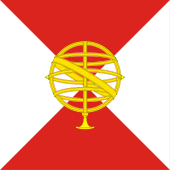
.jpg)
.png)